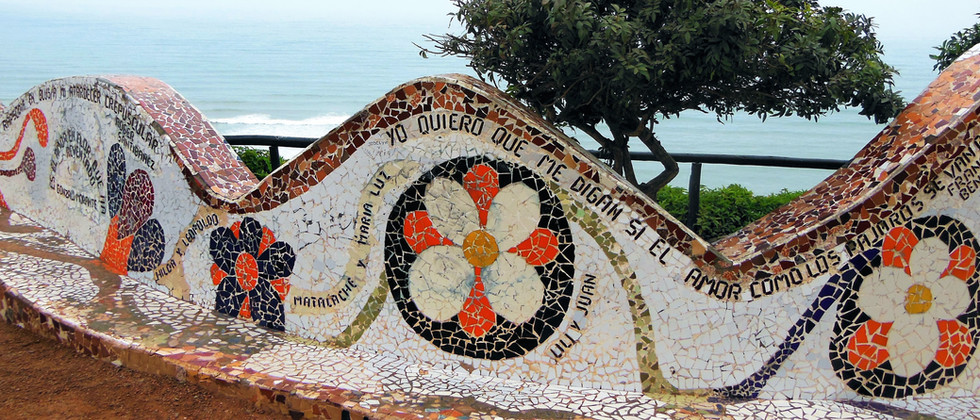We Were Caught Up in a Street Protest: Lima, Peru
- Steve

- Sep 9, 2012
- 4 min read
Updated: Apr 21, 2025
Peru was our first international destination and what a way to start - Lima, the Inca Trail and Machu Picchu. On the recommendation of a friend at work we also added a trip to Ecuador. Due to the multiple destinations, I've broken this trip into 4 separate blogs.
Lima
Inca Trail and Machu Picchu
Quito and Banos Ecuador
Our travels through Peru are mapped out below. We flew from Boston to Lima and stayed for 2 days. We then caught a flight from Lima (sea level) to Cusco (11,154 ft) but did not stay overnight and instead drove to Urubamba (9,514 ft). Heading straight to a lower altitude in Urubamba helps with acclimatization and prevents an immediate stay at greater than 10,00 ft.

Lima
Lima, as we know it today, was founded in 1535 by Francisco Pizarro who christened this land 'Cuidad de los Reyes' or City of Kings. Although the name didn't stick, over the next century Lima became the center of Spanish activity in South America. In 1535, Pizarro dedicated land for a main square of this new city. The Plaza de Armas, also known as the Plaza Mayor, became the ceremonial center of life in Lima. In its almost 500-year history Plaza Mayor has seen all the important events of Lima and Peru.

Throughout old Lima you see the famous balconies. The saying goes ... Paris has the Eiffel Tower, London has Big Ben and Lima has Balconies. There was is no better spot to see these balconies than the street surrounding the Plaza. Most balconies were built during the 17th & 18th centuries. These incredible feats of workmanship, with their intricate geometric carvings, were originally designed so the ladies of the house could look out on the streets of Lima without being seen.
Later balconies were added to religious buildings as a sign of power and influence. One of the most striking of these balconies was on the front of the Archbishop’s Palace that adjoins the Basilica Cathedral of Lima.


On the north side of the plaza is the Placio de Gomierno, the presidential residence and in Colonial times it was the home of Francisco Pizarro. Since the birth of the Peruvian Republic, the palace has served as the headquarters of the President of Peru. The present building dates back to the 1920’s.

On the west side is the Palacio Municipal that serves as the headquarters of Lima’s governing body. The building today dates to the 1940’s.

The center of the Plaza was once home to the city’s gallows. In 1578, the Spanish Viceroy of Peru had the gallows replaced with a fountain. This bronze water fountain in the plaza dates back to 1651.

On the east side of the Plaza is the Basilica Cathedral of Lima. The Basilica Cathedral of Lima or the Lima Cathedral was conceived and designed by Francisco Pizarro in 1535. The original building completed in 1538 was only a small adobe building but by 1625 the 3rd cathedral on the site was consecrated and Lima possessed one of the most important Catholic churches in Colonial times. The cathedral today is the result of 2 major reconstructions. In addition, four major earthquakes, the last occurring in 1940, led to further repairs and renovations. A picture of the exterior of the cathedral from the Plaza Mayor.

The main entrance to the cathedral.

The interior had a beautiful vaulted ceiling.
At the end of the nave was the main alter made of wood & covered in 22-carat gold leaf.

There were beautiful side chapels with ornate alters.


Oh, did I forget to mention that after touring the cathedral we exited to the Plaza where we found ourselves in the middle of a demonstration by teachers and healthcare professionals. A small clip of the protest observed from the steps of the cathedral.

When the demonstrators did not disperse, mounted police began marching down side streets toward the Plaza.
When that didn't stop the protest, this vehicle with screeching sirens appeared and began spraying the crowds with what looked like muddy water. At this point, people were running in every direction and we ran down a side street to avoid the mayhem.

Fortunately, we found ourselves outside the Church and Convent of San Francisco. It was great timing to get off the streets and take a tour of this building. The Spanish Baroque church was completed in 1674. In addition to the architecture, this church is famous for the catacombs where an estimate 25,000 bodies were laid to rest.

After we finished the tour, we walked back to Plaza Mayor. The protesters were gone, the Plaza was quiet and filled with tourist but there a police presence remained.


With these afternoon adventures behind us, it was time to relax. Life is great when you are 3700 miles from home and can still get a Dunkin's coffee.

We found a local street market with tons of vendors and decided to search for souvenirs.
On our second and last day in Lima, we woke up early and explored Parque del Amor, one of Lima’s most picturesque coastal parks. The artwork, sculptures and spectacular coastal views makes this park stand out from the others in the area. At the heart of this park is the huge sculpture ‘El Beso (The Kiss)’ which depicts two lovers locked in a romantic embrace.

Colorful mosaic walls lined the park.
Nice but foggy views of the Bay of Lima and the La Marina lighthouse.
Unfortunately, it was time to end our quick Lima excursion and head to the airport for the 90-minute flight to Cusco and the start of our Inca Trail adventures.

Click on the Return to Top or Arrow button in the lower right corner to navigate to the list of other Peru blogs.

























Comments